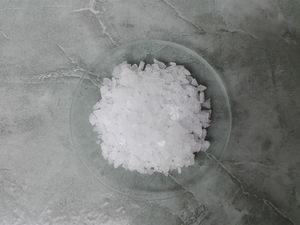Magnesium chloride
 A sample of hygroscopic food-grade MgCl2·6H2O
| |
| Names | |
|---|---|
| IUPAC name
Magnesium chloride
| |
| Systematic IUPAC name
Magnesium chloride | |
| Other names
E511
Nigari Nigari salt | |
| Identifiers | |
| Jmol-3D images | Image |
| |
| Properties | |
| MgCl2 (anhydrous) MgCl2·6H2O (hexahydrate) | |
| Molar mass | 95.211 g/mol (anhydrous) 203.31 g/mol (hexahydrate) |
| Appearance | White or colorless crystalline hygroscopic solid |
| Density | 2.32 g/cm3 (anhydrous) 1.569 g/cm3 (hexahydrate) |
| Melting point | 714 °C (1,317 °F; 987 K) 117 °C (243 °F; 390 K) (hexahydrate) |
| anhydrous 52.9 g/100 mL (0 °C) 54.3 g/100 mL (20 °C) 72.6 g/100 mL (100 °C) hexahydrate 167 g/100 mL (20 °C) | |
| Solubility | Soluble in conc. HCl, methanol Slightly soluble in acetone, ethanol, pyridine |
| Solubility in ethanol | 3.61 g/100 mL (0 °C) 7.4 g/100 mL (30 °C) 15.89 g/100 mL (60 °C) |
| Solubility in methanol | 15.5 g/100 mL (0 °C) 20.4 g/100 mL (60 °C) |
| Vapor pressure | ~0 mmHg |
| Thermochemistry | |
| Std molar
entropy (S |
89.88 J·mol-1·K-1 |
| Std enthalpy of
formation (ΔfH |
-641.1 kJ/mol |
| Hazards | |
| Safety data sheet | ICSC 0764 |
| Flash point | Non-flammable |
| Lethal dose or concentration (LD, LC): | |
| LD50 (Median dose)
|
2,800 mg/kg (oral, rat) |
| Related compounds | |
| Related compounds
|
Calcium chloride Strontium chloride Barium chloride |
| Except where otherwise noted, data are given for materials in their standard state (at 25 °C [77 °F], 100 kPa). | |
| Infobox references | |
Magnesium chloride, also known as Nigari, is a chemical compounds with the formula MgCl2.
Contents
Properties
Chemical
Magnesium chloride will react with calcium hydroxide to give magnesium hydroxide and calcium chloride:
- MgCl2(aq) + Ca(OH)2 → Mg(OH)2(pp) + CaCl2(aq)
Physical
Magnesium chloride is a white hygroscopic solid, soluble in water but poorly soluble in organic solvents, such as ethanol.
Availability
Magnesium chloride is available as tofu coagulant, more exactly as "Nigari flakes" or "Nigari salt". Some formulations also have magnesium sulfate.
Magnesium chloride sometimes occurs naturally as the mineral bischofite.
Preparation
Magnesium chloride can be prepared by reacting hydrochloric acid with magnesium metal, though this reaction is highly exothermic and magnesium metal is expensive.
- Mg + 2 HCl → MgCl2 + H2
Magnesium carbonate or magnesium hydroxide are much safer to use and much cheaper.
- MgCO3 + 2 HCl → MgCl2 + H2O + CO2
- Mg(OH)2 + 2 HCl → MgCl2 + 2 H2
A cheaper way involves the reaction of magnesium sulfate (Epsom salt) with calcium chloride.
- MgSO2 + CaCl2 → MgCl2 + CaSO2
The resulting calcium sulfate is filtered off and the magnesium chloride solution is gently heated at 100 °C to remove the water. Since a small amount will hydrolyze, adding hydrogen chloride gas/conc. hydrochloric acid will regenerate the magnesium chloride. Magnesium carbonate can also be used instead of Epsom salt, but since it's very poorly soluble, the reaction needs lengthy boiling under reflux (similarly to converting barium sulfate to carbonate).
To prepare anhydrous magnesium chloride, the hexahydrate is heated in a stream of hydrogen chloride.
Projects
- Make elemental magnesium (electrolysis of molten MgCl2 at temperatures over 714 °C, or of an eutectic mixture of MgCl2-KCl-NaCl above 475 °C)
- Home-made desiccator
- Make tofu
Handling
Safety
Magnesium chloride is deliquescent and its anhydrous form may cause irritations on contact with skin, eyes or mouth.
Storage
Because of its hygroscopicity, magnesium chloride must be stored in an air-tight container.
Disposal
Magnesium chloride can be safely poured down the drain.
References
Relevant Sciencemadness threads
- Chemical pages without CAS Registry Number
- Articles without EBI source
- Chemical pages without ChemSpiderID
- Chemical pages without DrugBank identifier
- Articles without KEGG source
- Articles without InChI source
- Articles without UNII source
- Articles containing unverified chemical infoboxes
- Chemical compounds
- Inorganic compounds
- Magnesium compounds
- Chlorides
- Hygroscopic compounds
- Irritants
- Neutral salts
- Easily prepared chemicals
- Readily available chemicals
- Materials available as food grade
- Minerals